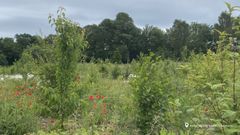Jul 24, 2024
Visiting our Kalundborg forest: the benefits of local forest projects for businesses
Join us on a visit to Kalundborg Forest to learn about our sustainable forestry, see the progress of the forest and discover how our local projects impact the environment

Imagine stepping into a lush, green young forest where the trees you see were planted just a few years ago, transforming former farmland into a thriving ecosystem. This is the reality of Kalundborg Forest in Denmark.
Local project = local impact
One of the many benefits of focusing on local projects is that they are easily accessible for visits. We prioritise developing projects close to our clients in Europe to make the impact more tangible. It’s much easier to relate to trees being planted an hour or two away from your office than on the other side of the world. Recently, our Copenhagen team had the opportunity to visit the Kalundborg Forest as part of a team-building day. This visit allowed us to see firsthand how the forest was progressing and to learn more about our sustainable forestry efforts.
Psst…Visiting the forests isn't just for the EcoTree team. If you and your colleagues wish to visit the trees we have planted on your behalf or explore one of our forests, please contact us. We’ll help arrange the details for your visit.
In June 2024, we had another chance to show the forest to a local TV news station, where we found some of the trees were almost taller than our CEO, Thomas!

Let’s start by turning back time…
We acquired the area near Kalundborg, more precisely in Forsinge, back in 2021 and planted the trees in the spring of 2022. The area was previously agricultural land and is currently surrounded by agricultural fields. Based on soil studies and an analysis of the surrounding areas, we drafted a unique planting plan and a forest management plan that considers the next 219 years of the forest.
We planted a variety of species, including Sessile Oak, Hornbeam, Black Alder, Apple, Sycamore Maple, Douglas Fir, and Norway Spruce. The Oak trees will form the heart of the forest in its early stages and eventually the Maple trees will take over.
In just two years, the trees will be between one and two meters tall and they will keep growing rapidly over the next few years. Learn more about a tree’s life cycle here and discover more about the Kalundborg forest on its dedicated forest page.
We also installed six beehives in 2022, based on the results from a study done by FaunaPhotonics of the insect activities on the plot. The bees will help pollinate the area and provide honey for our clients who financially support the bees. This is great news as the forest is neighbour to Forsinge Jættestue, a historic site from the Vikings, and leaves us with a protected area, where we cannot plant trees but have left it as a meadow, with lots of food sources for the bees!

The benefits of forest visits for clients and employees
Visiting a forest project that your company has financed can have numerous benefits for employee engagement and your communication. Firstly, it allows employees to see the tangible results of their company's contributions, fostering a sense of pride and accomplishment. This hands-on experience can enhance team cohesion as employees work together in an outdoor, nature-filled setting.
Moreover, these visits can serve as powerful communication tools. Employees who have seen the project firsthand are better equipped to share stories and insights about their company’s sustainability initiatives with colleagues, clients, and partners. This authentic communication can enhance the company's reputation and demonstrate its commitment to sustainability.
We always share communication kits with our clients to provide them with guidance on how to communicate about their contribution.
So, what’s next?
This autumn, we will start weeding out competing plants between the planting lines to give the trees more space to grow. The fence around the forest will remain for a few more years to protect the trees from wildlife, such as deer, which like to nibble on the tree buds.
Our Kalundborg forest is sold out, but there are plenty of other exciting Danish forest projects on Møn, Nysum, and the island of Orø. Contact us to hear more about our upcoming projects and how you can get involved.
